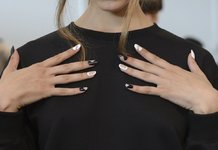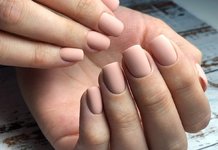
Not every beauty was lucky to have beautiful nails by nature, so the procedure of building up with its appearance made a real sensation in the world of manicure art. It is available in several variations:
• acrylic;
• gel;
• false nails (nail tips).
Today we suggest discussing the topic of nail extension. During the discussions in the proposed article, we will find out which technique is better and safer, what material for manicure is better to choose, and also get acquainted with user reviews.
Gel for nail extensions which is better
Manicure masters use two main tools for this purpose: acrylic and gel. The technique is exactly the same: removing the top layer and forming a new shape. The main difference is noticeable to the master: acrylic freezes much faster and this requires certain skills (a more complex process). But what is better to choose? We recommend finding out the answer to this question below.
Acrylic or gel for nail extensions, which is better?
To understand which material is better, you need to know how they differ. Both tools for manicure masters have their pros and cons.
Pros of acrylic:
• Acrylic is a durable material that allows you to form thinner nails (similar to natural ones);
• less toxic;
• it can be removed without filing, which reduces the time of the procedure.
The advantages of the gel:
• the adhesion of the product to the nail plate is very strong, which allows the new decoration to last up to 4 months;
• the structure of the product allows you to create various designs, up to foreign inclusions (beautiful nail art): sequins, dried flowers, etc.
Of the minuses of acrylic can be noted: the inability to use nail polish with this type of building and the unpleasant aroma of the material.
For the second remedy, negative qualities: after breaking, the nails cannot be restored, a more fragile structure in comparison with acrylic, the nails look unnatural due to the thickness of the new plate (artificial material is noticeable), and the removal takes place by the sawing method, which significantly stretches the process, besides it can cause damage.
Gel for nail extension single-phase
There are three types of gel that are used by manicurists: single-phase, two-phase and three-phase. Which is better to choose?
Single-phase is more often chosen by beginners, since it is easy to use and does not require additional elements. The procedure in its variant is as follows: an apex zone is formed (in forms) and the ends are sealed, then drying under an ultraviolet lamp.
Two and three phase significantly complicate the process, since in their case two or three types of funds are used at once: the base, the forming (sculptural) and the finishing. In this embodiment, the build-up takes longer, but the final result is excellent.
What is the best gel for nail extensions?
User reviews are based on their own experience of building, from the recommendations you can make the following - when choosing material for building, you need to be based on three main markers:
• viscosity of the material and features of its solidification (some types require the action of an additional catalyst);
• availability of a quality certificate;
• lack of a pungent odor (quality material has a moderate concentration of aroma).
An important factor is the manufacturer. The best for today you can choose from the following companies:
- Formula Profi (better for working with tips),
- Irish Professional,
- Global (great for beginners manicure),
- Lina (single phase),
- CNI (three phase)
- Ibd (hypoallergenic).
Any material can be ordered via the Internet, at the same time compare prices, for example, in Moscow and Kiev and choose the most advantageous offer.
Nail gel which is better reviews
Studying in detail the reviews of women on the Internet and photos, the results of the work of manicure masters, the conclusions can be mixed. Both acrylic and gel have gathered an impressive group of fans. Positive feedback on the first remedy is based on the simplicity of the procedure, the nails look the closest to the natural ones, etc.
Negative reviews: it does not allow the use of varnish and thus diversify the design, as well as the strong smell of the material, which disappears only a few hours after nail extension.
Reviews about the second remedy are also more positive. They especially note the simplicity of the technology and the ability to use it at home, but here you can also see the mention of the difficulties of removing the gel (we recall that this is possible only by mechanical means), which causes discomfort and discomfort during work. But in the end, the answer to the question of which is better to choose and with which tool to work better depends on the desired result and user skills.

























